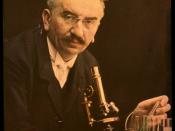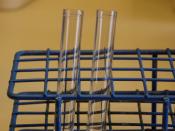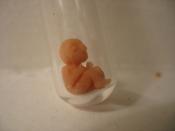Effect of the halogen atom on the rate of hydrolysis
Aim: to find the rate at which different halogenoalkanes hydrolyse to form a sliver precipitate in silver nitrate solution.
Hypothesis: I think that 1-iodobutane will be the fastest to react followed by 1- bromobutane and then by 1-chlorobutane. This is because 1-iodobutane has the lowest bond energy out of the three and I think that this will make it easier for it to react with the silver nitrate.
Method. Three test tubes will be placed in a test tube holder. Into each test tube 1 cm" of ethanol will be added. The test tubes will be numbered 1 to 3 and the same molar mass of 1-chlorobutane, 1-bromobutane and 1-iodobutane will be added correspondingly. A forth test tube will contain 5 cm" of silver nitrate. All four test tubes will be placed in a water bath set to 50ðc.
the test tubes will be left in the water bath for about 10 minutes so that they all reach thermal equilibrium. Once they have all reached the same temperature the test tubes will be removed and 1 cm" of the silver nitrate will be added to the numbered test tubes. A stopper will then be placed on each test tube and the tubes will be shaken to mix the solutions. This will have to be done very quickly and the time taken note of. A timer will be started and after every minute the order of the test tubes with the most precipitate will be recorded.
To make this a safe experiment safety gloves, lab coats and safety glasses will be worn at all times. This will make sure that if any chemicals are split on clothes of on the skin the will not cause that much damage. The test...


